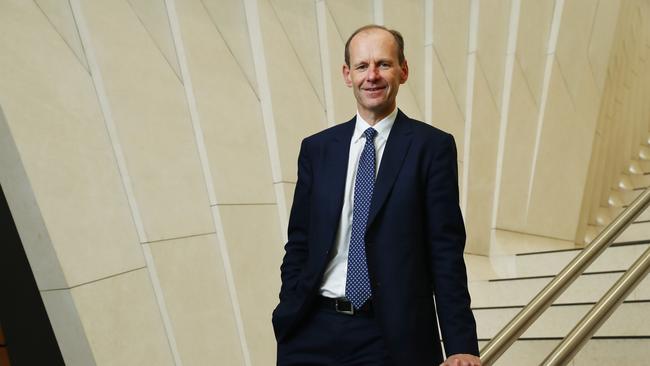ANZ chief Shayne Elliott ends sales-driven bonus system

The ANZ chief will announce that, from October 1, the only variable pay received by about 80 per cent of staff will be a slice of the group performance dividend.
The dividend is to be determined by a scorecard that includes risk, financial, customer and people benchmarks, with the bank’s reputation also pivotal.
Elliott conceded that the new system — one of 16 initiatives flagged in last February’s response to the findings of the royal commission — would not by itself usher in a more sustainable culture.
“But without a more coherent and aligned remuneration structure it’s impossible to get the cultural reform that you need,” he told Four Pillars.
Keen to rebut the notion that ANZ could lose its performance edge, Elliott said he was not trying to create some kind of socialist nirvana where everyone was deemed to be equal.
Hurdles would have to be cleared to qualify for a share of the dividend, so it wasn’t just a matter of turning up to work.
Staff who failed to “live ANZ’s values” wouldn’t get anything.
The size of an individual’s dividend would also depend on seniority. For someone quite junior, the dividend share could amount to 2-2.5 per cent of their base pay in a good year.
ANZ said the rest of the workforce, who were mostly in senior positions with a greater ability to impact group performance, would still have a slice of their pay “at risk”, which would be calculated according to the business unit and individual performance.
Variable pay for a trader or an executive managing a network of branches, for example, could be 20 per cent of base pay — much lower than the current system allows, and with appropriate deferrals in place.
Overall, the changes would be cash-neutral for ANZ — fixed pay would go up, but it would be funded by smaller bonuses.
The intention, according to Elliott, was to retain a high-performance culture, while lifting the level of collaboration across the group to improve outcomes for customers, shareholders and the community.
ANZ, like Westpac and NAB, is facing a second strike on its remuneration report at this year’s annual meeting.
Elliott said further pay changes, this time for members of the management board, were likely before the AGM as the bank tried to avoid a potential board spill. However, given that the remuneration report was passed by shareholders — albeit with a 34 per cent “no” vote — the basic structure of the remuneration report would remain intact.
One of the changes that would be made was to deferral periods for incentives.
Word on the street
A market divorced from fundamentals? Say it ain’t so!
Over the last few months, a puff of speculative wind has inflated Commonwealth Bank’s value to an extraordinary, 17.4 times forecast 2020 earnings — a record for any large, developed-market lender worth more than $US100 billion, according to UBS bank watcher Jon Mott.
However, the expectation that CBA will transform the speculation into substance by announcing a capital return in tomorrow’s full-year result is wide of the mark.
The word on the street is that CEO Matt Comyn will update investors on a slate of planned asset sales, following Friday’s completion of the $4.2 billion exit from Colonial First State Global Asset Management. The CFSGAM deal, struck at an eye-popping 19.4 times cash earnings, means that a buyback is officially on the radar.
Directors, though, will wait for the “completed” placard to be hoisted above announced transactions, such as the sale of BoComm Life.
The BoComm Life deal is the final condition precedent for the sale of CommInsure Life and is subject to Chinese regulatory approval.
There’s also the thorny issue of the Reserve Bank of New Zealand’s capital proposals, which CBA has said could result in an additional tier one capital requirement of $NZ3 billion ($2.9bn).
The bank’s common equity tier one capital at the end of March was 10.3 per cent — comfortably within range of the prudential regulator’s 10.5 per cent target.
CBA said in its third quarter trading update in May that announced asset sales would add a further 120 basis points to its CET1 ratio. Clearly there is some surplus capital to play with, but the extent of it is still uncertain.
That’s why it makes sense for the board to hold off making any announcement, at least until the first half of the 2020 financial year.
CBA is likely to reverse some of its recent gains on Wednesday if the delay is confirmed.
Over the last six months, the bank’s total shareholder return (share price growth plus reinvested dividends) is an attractive 19.5 per cent.
Even then it hasn’t led the major bank sector. That honour goes to beleaguered NAB, which has rallied in response to the appointment of Royal Bank of Scotland boss Ross McEwan as its new chief executive. NAB’s six-month TSR is 21.2 per cent.
gluyasr@theaustralian.com.au
Twitter: @Gluyasr



The last rites will be read to ANZ Bank’s bonus system on Tuesday, as chief executive Shayne Elliott seeks to smash a toxic, sales-driven industry culture that prioritised short-term profitability over trust and reputation and led to last year’s royal commission.